- Hidden Crosses in the Dushanbe Archeology Museum
- Hidden Crosses in Khujand Archeology Museum
- Geometric Cross-like Designs of Tajikistan
- Key Displays on Rudaki Street in Dushanbe
In Tajikistan, there is a clueless acceptance of Christian ideas on display in history and the streets today. On a recent visit, incorporating biblical concepts like the cross-like patterns confounded me. Places like museums, cultural displays, and handcrafts gave credence to Christian symbols. Where did this unintended pattern come from?
Tajik Cross-like Patterns
The massive display of cross-like patterns links to designs in Tajik history. Geometric patterns dominate, as do those with Christian crosses. The cross is an essential Persian design.
Link to Bukhara
The Samanid Empire[1]Tajik literature calls them Somoni centered their rule in Bukhara from 819 to 1005 AD. The empire encouraged art, literature, and science under its development, which linked to the ideas of Central Asia during those times.
The Samanid Rulers were undoubtedly the first Persian Sunni rulers and influenced history for centuries. However, the sources of influence on the patterns they developed need consideration. The essential king, Ismail-i Samani, and his family seem to connect to Balkh and/or Hephthalite, of which both regions or peoples hosted some of the early Christian churches in the region. Christianity in Balkh dates from the second century after Christ and the Hephthalites from at least the 5th century. Despite the mixing of religions like Buddhism in the area, there seem to be Christian artisans that helped form the early Tajik designs.
In the book about Bukhara, the authors state when the Arab caliphates came, “The conquerors demanded denunciation of existing religious beliefs in the region and imposed Islam… In protest, something like 700 wealthy families of Bukharian merchants moved out of Bukhara and settled in keshks – fortified settlements since the invaders did not spread out to the rural areas.”[2]Bukhara: A Museum in the Open T.Pulatov and L.Y. Mankovskaja, 1991, 71 This is where the former patterns most likely came from. The making of rugs and wealth that existed in the city still retained its former ways. The departure of these families in 708 AD preserved the patterns, since their migration prevented a change to Islamic Arab ones. Their isolation, at least initially, preserved their symbols.
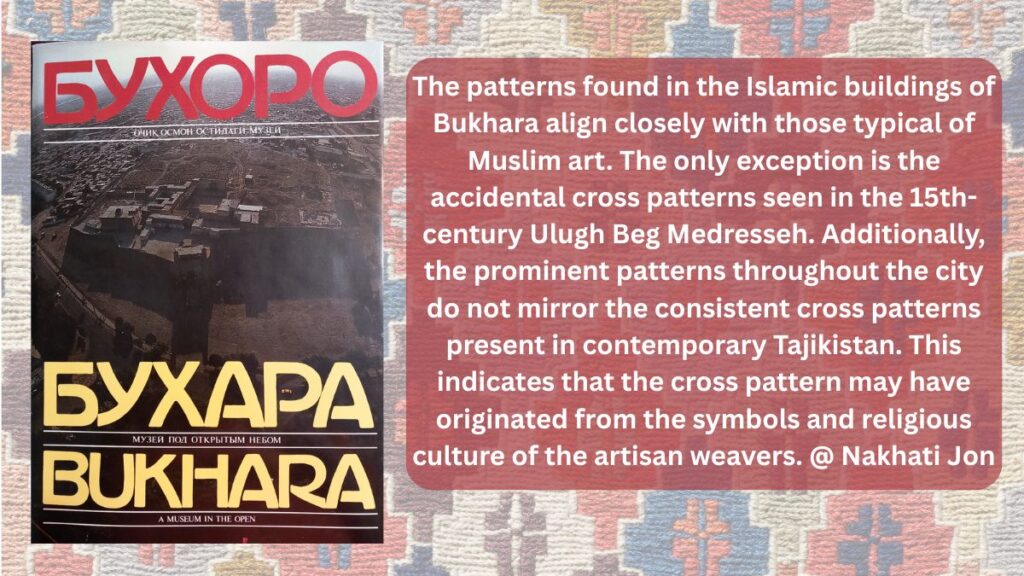
Other Central Asia sites
Islamic patterns today in Iran differ—they are more geometric circles and squares with multi-pointed stars and a strong emphasis on calligraphy. They are often associated with mathematical ideas. The Bukhara pattern is based on two things: four-point shapes and floral designs. In other Islamic geometric patterns, the four-sided polygon is emphasized, but in the Bukharin motif, the four-point cross-like pattern dominates.
Looking at the four-star type of cross, could this be an image of a star? In history, we know that Samarkhan was a center for Astrology, and the Ulugh Beg Oservatory displays a cross in the shape of an “X” and a four-point cross. Yet, we know the cross-designs were found before this 15th-century building.

The Metropolitan Museum of Art displays a ceramic bowl from Nishapur during the Samanid Empire. This 10th-century design of a cross-like pattern centered their art from an early stage. The geometric design repeats the cross pattern with heart and flowery motifs surrounding the central cross. The excavated site shows cross patterns in some objects found.[3]picture from https://www.metmuseum.org/art/collection/search/449711 – stating Arabic blessing for life and prosperity.
Possible Sources of the Cross-like Pattern
The Christian artists of that time developed cross-patterns in Suzanis, as well as rugs and wall patterns. The Bokhara rug is known for its red/white cross patterns, which some describe as diamonds or oval motifs.[4]https://www.loveyourrug.ca/area-rug-blog/all-about-bokhara-rugs Yet, unmistakably to any Christian, the cross patterns highlight this famous rug. Most likely, a Christian Persian or Uzbek tribe developed the design, which today is reproduced—also, the design’s redness hints at Christ’s sacrificial death.
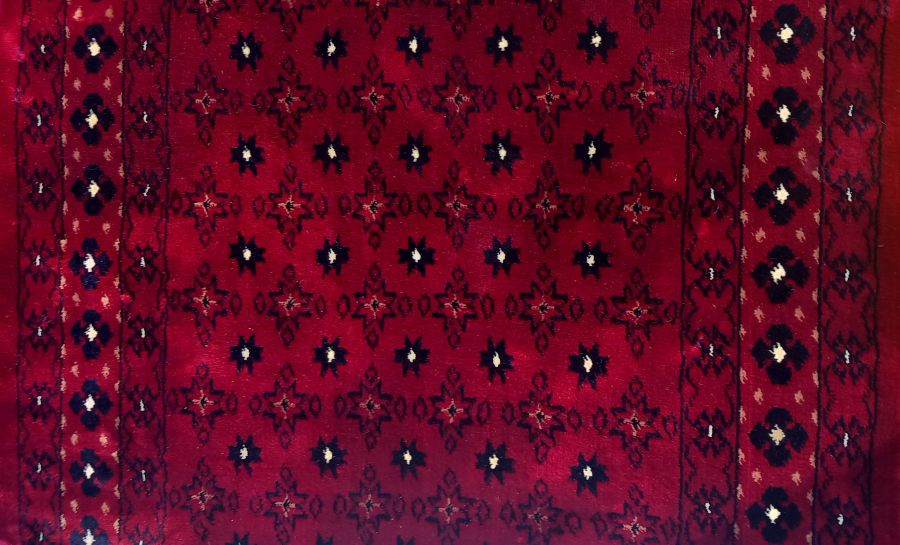
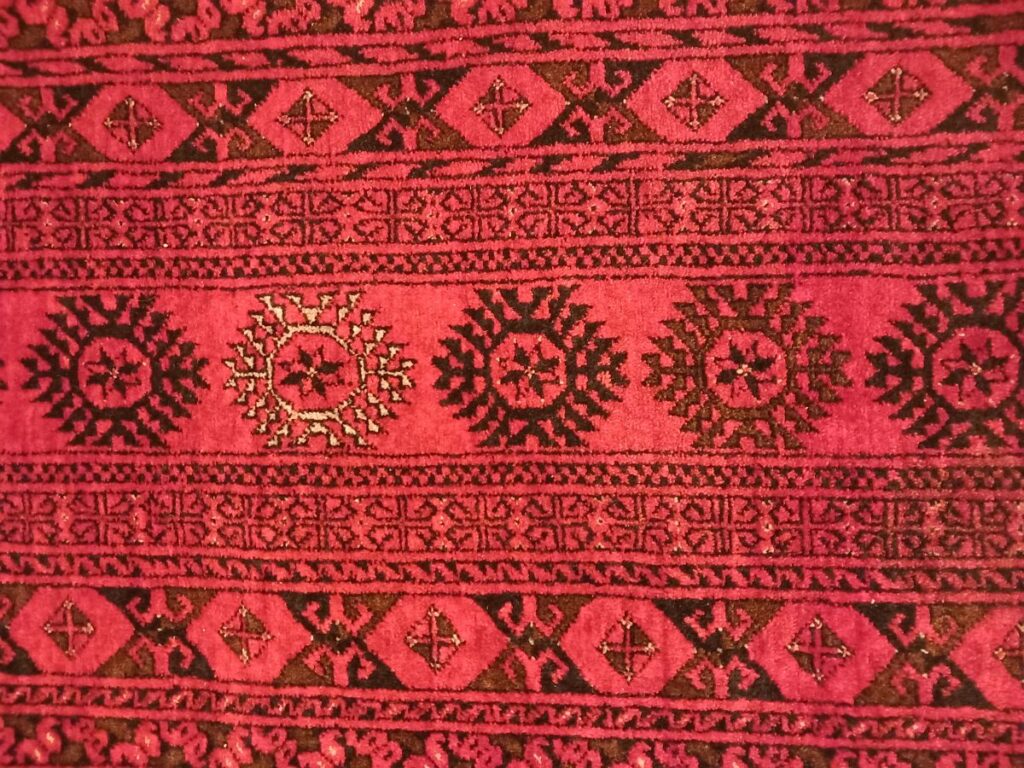
For believers, the rug exhibits the red cross that gives remembrance of Christ’s sacrificial death. Many will scoff at these ideas, but why repeat prominent crosses and overemphasize red? In seeing the Bokhara Oriental Design, the multiple ways to show forth the cross is demonstrated. Many, and even at times, portrayed a symbolic three-cross pattern that resembles the death of Christ between two other crosses. For a Christian to follow the way was to walk and bear the cross, so finding these images on rugs gave a reminder to their life in Christ.
From the 5th to the 9th century, believers loved to display the cross. This is evident in the remains of Ephesus, Constantinople (Istanbul), and Central Asian archaeological finds. The early church focused on the cross, depicting it in designs, graves, and artwork.
Soghdian patterns mix in their depictions, but cross-like figures dominate certain patterns that have been found. Check out the elaborate coat displayed in the Cleveland Museum of Art. The early believers in Soghdia, Bukhara and Samarkhan incorporated the cross design into their everyday patterns.
Walking in the way of the cross was the norm for Christians so they were urged to follow Christ, the path or way. Displaying the cross on tiles or rug patterns never was considered dishonoring but a way to remind them to follow Christ.
Suhrob Art Gallery
In central Dushanbe, across from Parliament (Мачлиси Олй), sits a gallery that displays numerous Tajik crosses—not just one but multiple crosses in designs—on ancient jugs and ceramic art. The dominant pattern cannot be ignored. Christianity encourages art and depictions to give an external value to life.
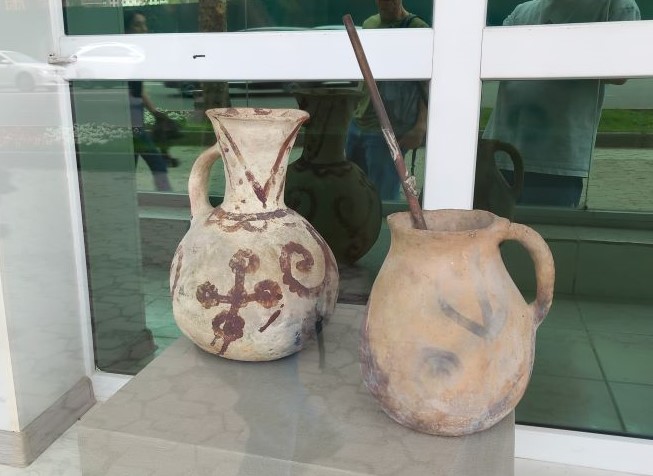
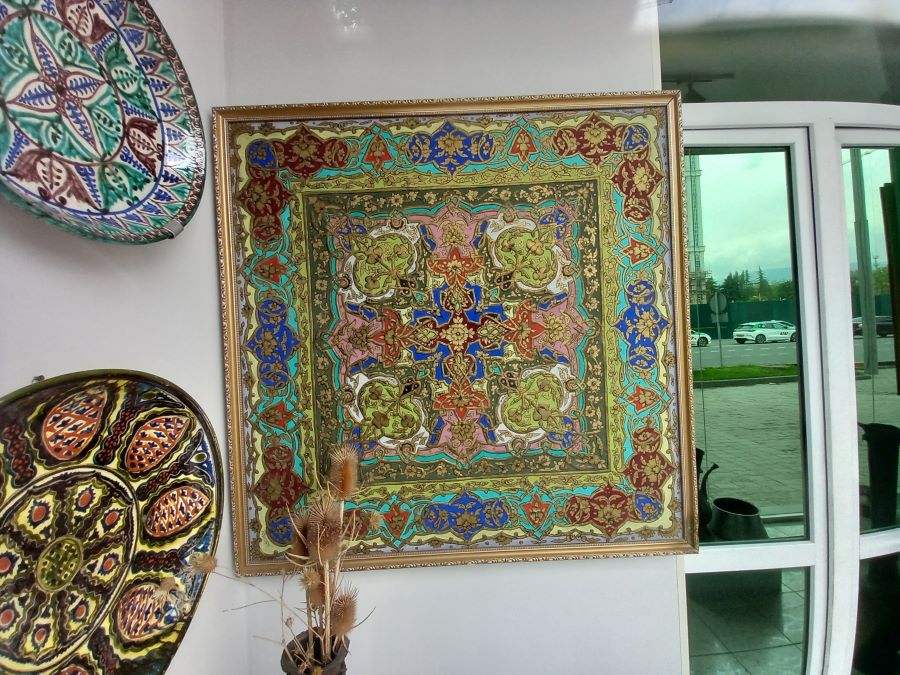
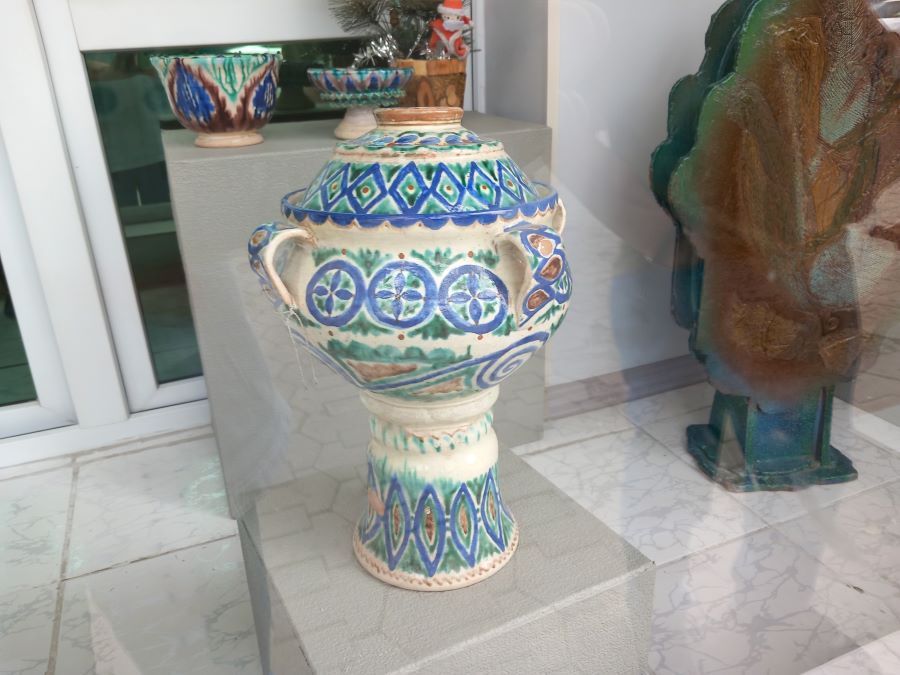
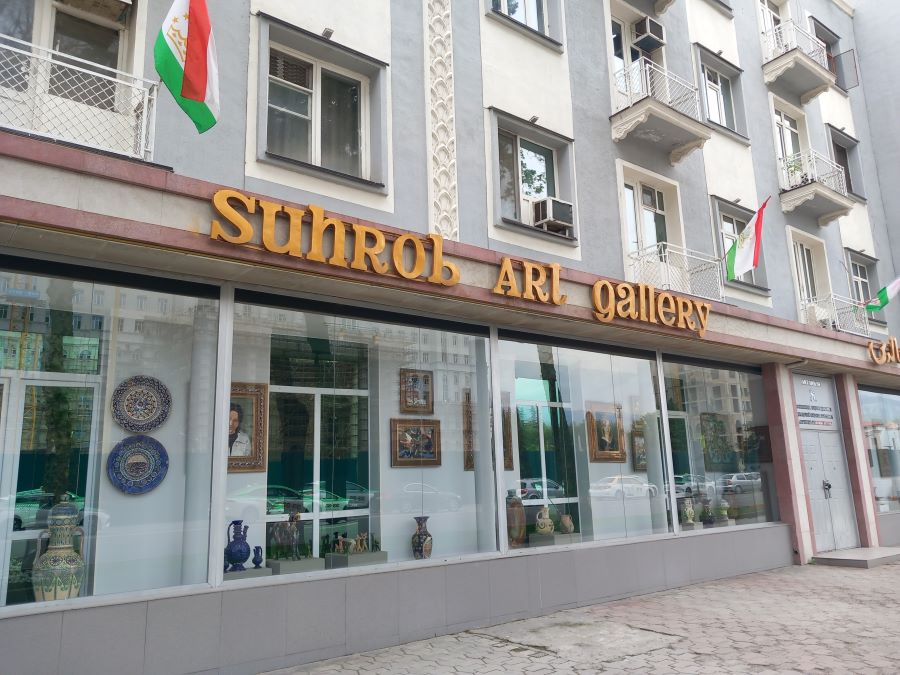
Hulbuk Patterns
The cross-like pattern is found in the walls of the historical 9th—to 10th-century remains of Hulbuk, the former capital of Khatlon. The four leaves or, at times, four directional points repeat in the original design patterns found in Hulbuk’s wall moldings. Despite this location being an outlining fort from the Bukharin rulers, it adopts patterns that they most likely saw in their capital.
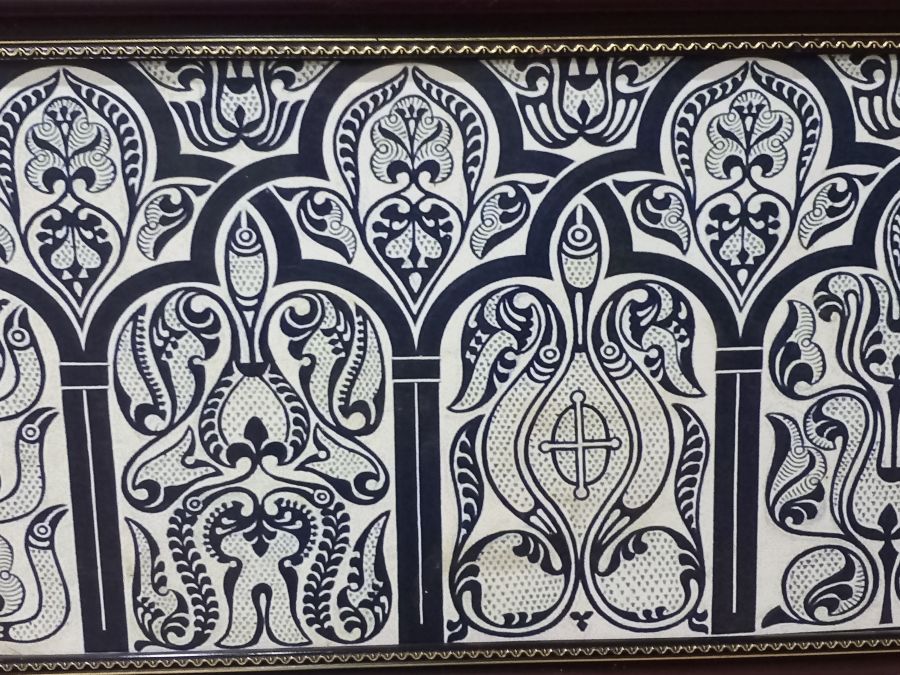
Many of the designs in the Hulbuk Museum present floral crosses and four-point crosses. I will soon write about this museum, yet I have placed it on TripAdvisor.
Suzani Cross-like Patterns
The embroidery of Central Asia represents the rural depiction of life. These beautiful patterns reflect floral designs and images of harvest. In addition, many cross-like patterns show in the display. The history of these works of art has not been studied as it should. Yashar Bish said, “Throughout Central Asia, individual regions developed their distinctive designs, for this part of the world is a human as well as a topographical patchwork: Khazakhs, Kyrgyz, Uzbeks, Turkomans, Lakai and Arabs live there and, within those groups, each tribe had its göl, or crest, with colors and motifs that were recognizable at a marketplace or on pilgrimage.”[5]https://www.yashar-bish.com/about-central-asian-suzanis.html In the same way, the Christian believers throughout the region had their crest and colors that became recognized by others. Amazingly, the dominant pattern seems to be flowers and crosses, so what does that tell us about these motifs?
Peruse of Tajik Museums
Tajik Textile Suzani crosses find dominance in the museums of Tajikistan like Khujand, Kulob and Hulbuk. The one on the right hangs in the Hulbuk Museum and gives many designs apparent today.
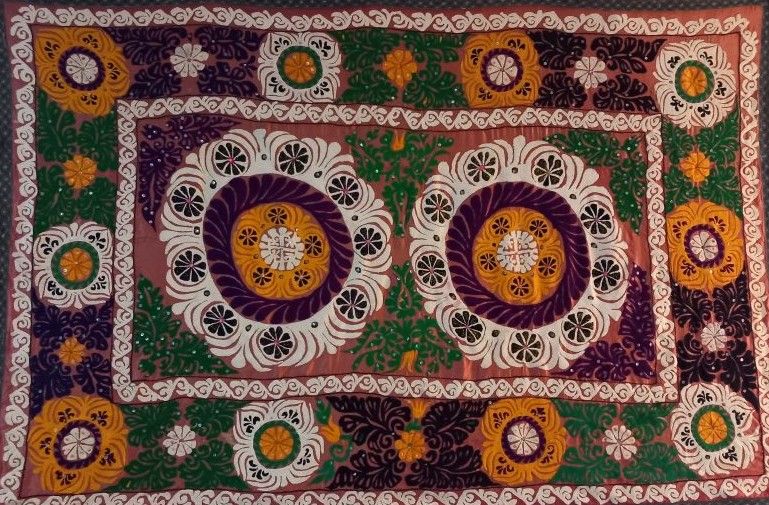
Today’s designs hint at an unintentional pattern that no artists today or the approving political authorities desired to convey. The four-prong designs give a Tajik sense rather than an Arabic one. The cross-like pattern stresses the history and creativity of Tajiks rather than any outside influence. Unique to their setting, these patterns give color and honor the greatness of Tajik craftsmanship.
References
| ↑1 | Tajik literature calls them Somoni |
|---|---|
| ↑2 | Bukhara: A Museum in the Open T.Pulatov and L.Y. Mankovskaja, 1991, 71 |
| ↑3 | picture from https://www.metmuseum.org/art/collection/search/449711 – stating Arabic blessing for life and prosperity. |
| ↑4 | https://www.loveyourrug.ca/area-rug-blog/all-about-bokhara-rugs |
| ↑5 | https://www.yashar-bish.com/about-central-asian-suzanis.html |
Leave a Reply